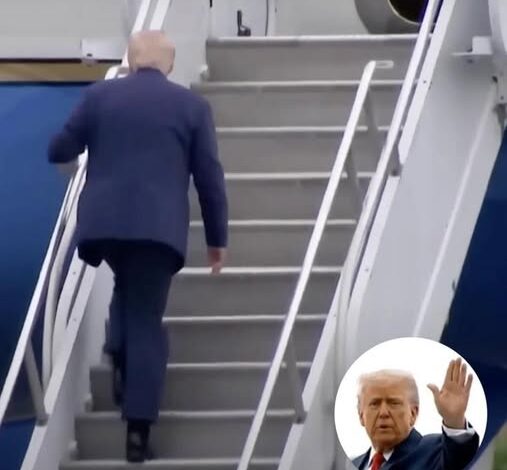
President Donald Trump became the subject of viral chatter earlier this month after cameras captured him briefly stumbling while climbing the stairs to Air Force One. The incident, which took place on June 8 in Morristown, New Jersey, immediately drew comparisons with past political moments—but the reaction may say more about bias and memory than about Trump himself.
The president had just concluded remarks to reporters before heading toward the aircraft for a short flight to Camp David. Accompanied by Secretary of State Marco Rubio, Trump waved to the press as he approached the stairway. As he climbed, he momentarily lost his footing but quickly regained balance and continued inside without further issue. Rubio, following behind, also tripped slightly on the steps.
Cameras from multiple outlets captured the moment, and clips spread rapidly across social media platforms. Within hours, the stumble had been viewed millions of times, with both critics and supporters weighing in. Some opponents pounced, mocking the 78-year-old president’s misstep as a sign of age. Supporters countered that it was little more than a trivial slip, no different from what anyone might experience, and that the online frenzy revealed a glaring double standard.
Comparisons with Biden
The comparisons were inevitable. In March 2021, then-President Joe Biden drew headlines after falling repeatedly while attempting to climb the same set of stairs leading into Air Force One. That moment, which the White House at the time blamed on a gust of wind, raised persistent questions about Biden’s health and stamina. The footage became a symbol for critics who argued he was physically and mentally unfit for the demands of the presidency.
Trump’s campaign later made those images central to the 2024 election narrative. Ads with titles such as Jugular and Not a Young Guy framed Biden as too frail to serve a second term. Combined with Biden’s uneven debate performances and public struggles to maintain coherence, the physical stumbles fueled broader doubts about his capability.
Ultimately, those doubts proved consequential. Biden ended his reelection bid following a widely criticized debate with Trump in which he faltered through responses. Soon after, reports surfaced of his advanced cancer diagnosis, prompting questions about how much the public had been told during his final year in office.
Legacy of Concealment
Biden’s health revelations have cast a long shadow. Trump, now back in the White House, has directed the Department of Justice to investigate whether Biden’s staff improperly relied on an autopen to sign executive orders in his final months, raising concerns about transparency and decision-making during that period. Biden has dismissed the inquiry as politically motivated, but many argue that the American people deserve answers about how much was concealed.
Against that backdrop, the focus on Trump’s minor stumble feels disproportionate to supporters. Unlike Biden’s dramatic falls, Trump’s misstep was fleeting and quickly corrected. Yet critics amplified it across social media as though it revealed something significant about his age and capacity.
Age and Energy
By the end of his current term, Trump will be 82—the same age Biden was when he left office. The contrast, however, is central to the political debate. Trump’s allies emphasize his schedule, stamina, and public presence as proof that he remains sharp and engaged. His rallies still draw tens of thousands, his speeches often last over an hour without notes, and his media presence remains relentless.
In their view, the stumble on June 8 is a meaningless blip in an otherwise vigorous presidency. Far from a symbol of weakness, they argue, the incident highlights how critics search for any opportunity to undermine him while ignoring the broader record.
Media Reaction and Bias
The episode has also reignited discussion about media coverage. Conservatives point out that Biden’s falls in 2021 and afterward were often explained away by sympathetic outlets, while Trump’s minor slip is treated as headline material. They argue that the selective outrage reflects deeper bias, with mainstream media quick to magnify Trump’s flaws while downplaying or excusing those of his rivals.
Supporters note that Trump has spent years under relentless scrutiny, with everything from his diet to his golf swings dissected for meaning. In this case, they contend, a split-second misstep became viral fodder not because it mattered, but because it was Trump.
Larger Implications
Whether the stumble has any political consequence remains doubtful. Most Americans will likely forget it within weeks. Yet the reaction to it underscores how physical moments—real or exaggerated—can shape perceptions of leadership in an era where images travel faster than context.
For Biden, the imagery of repeated falls came to symbolize fragility and helped end his political career. For Trump, the challenge is different: to show that age has not dulled his vigor and that his brief slip is just that—a slip, not a symptom.
Conclusion
As Trump boarded Air Force One that day, he waved to the cameras, steadied himself, and carried on with his duties. For critics, the stumble was an opportunity to score points. For supporters, it was evidence of how far opponents will go to manufacture a narrative. And for the broader public, it served as a reminder of the intense spotlight presidents live under, where even the smallest misstep can become global news.
In the end, the difference may not lie in the stumble itself but in what people choose to see. Biden’s falls became emblematic of decline. Trump’s brief misstep, so far, appears destined to be remembered as another viral flashpoint in a presidency defined by spectacle, scrutiny, and resilience.